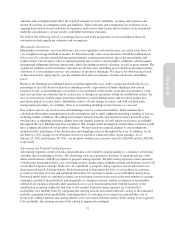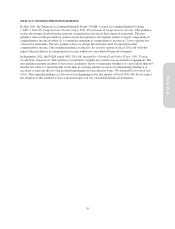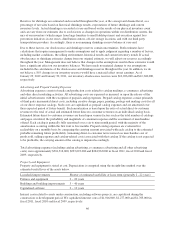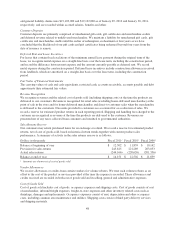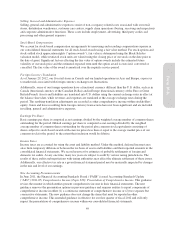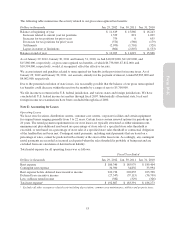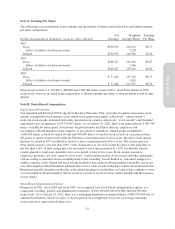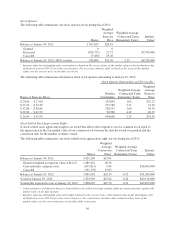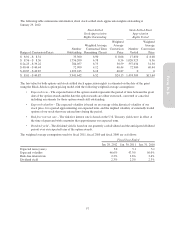Pottery Barn 2011 Annual Report Download - page 61
Download and view the complete annual report
Please find page 61 of the 2011 Pottery Barn annual report below. You can navigate through the pages in the report by either clicking on the pages listed below, or by using the keyword search tool below to find specific information within the annual report.
We review the carrying value of all long-lived assets for impairment, primarily at a store level, whenever events
or changes in circumstances indicate that the carrying value of an asset may not be recoverable. Our impairment
analyses determine whether projected cash flows from operations are sufficient to recover the carrying value of
these assets. Impairment results when the carrying value of the asset exceeds the estimated undiscounted future
cash flows over its remaining useful life. For store impairment, our estimate of undiscounted future cash flows
over the store lease term (generally 5 to 22 years) is based upon our experience, historical operations of the stores
and estimates of future store profitability and economic conditions. The future estimates of store profitability and
economic conditions require estimating such factors as sales growth, gross margin, employment rates, lease
escalations, inflation and the overall economics of the retail industry, and are therefore subject to variability and
difficult to predict. If a long-lived asset is found to be impaired, the amount recognized for impairment is equal to
the difference between the net carrying value and the asset’s fair value. Long-lived assets are measured at fair
value on a nonrecurring basis using Level 3 inputs as defined in the fair value hierarchy. The fair value is
estimated based upon future cash flows (discounted at a rate commensurate with the risk and that approximates
our weighted average cost of capital).
For any store or facility closure where a lease obligation still exists, we record the estimated future liability
associated with the rental obligation on the cease use date.
During fiscal 2011, we recorded expense of approximately $3,194,000 associated with asset impairment and
early lease termination charges for underperforming retail stores, of which $2,819,000 is recorded within selling,
general and administrative expenses, and the remainder of which is recorded within cost of goods sold.
During fiscal 2010, we recorded expense of approximately $17,525,000 associated with asset impairment and
early lease termination charges for underperforming retail stores, of which $16,384,000 is recorded within
selling, general and administrative expenses, and the remainder of which is recorded within cost of goods sold.
We also recorded a net benefit of $403,000 associated with the exit of excess distribution capacity, which is
recorded within selling, general and administrative expenses.
During fiscal 2009, we recorded expense of approximately $35,024,000 associated with asset impairment and
early lease termination charges for underperforming retail stores, of which $32,898,000 is recorded within
selling, general and administrative expenses, and the remainder of which is recorded within cost of goods sold.
We also recorded charges of $7,580,000 associated with the exit of excess distribution capacity, of which
$5,981,000 is recorded within selling, general and administrative expenses, and the remainder of which is
recorded within cost of goods sold.
Goodwill
At January 29, 2012, we had goodwill of $19,301,000 included in other assets, net, primarily related to our fiscal
2011 acquisition of Rejuvenation (see Note N). Goodwill is not amortized, but rather is subject to impairment
testing annually, or between annual tests whenever events or changes in circumstances indicate that it is more
likely than not that the fair value of a reporting unit is below its carrying amount. Events that may result in an
impairment review include significant changes in the business climate, declines in operating results, or an
expectation that the carrying amount may exceed fair value. We assess potential impairment by considering
present economic conditions as well as future expectations. If the carrying value of the reporting unit’s assets and
liabilities, including goodwill, is in excess of its fair value, impairment may exist, and we must perform a second
step of comparing the implied fair value of the goodwill to its carrying value to determine the impairment charge,
if any.
Self-Insured Liabilities
We are primarily self-insured for workers’ compensation, employee health benefits and product and general
liability claims. We record self-insurance liabilities based on claims filed, including the development of those
claims, and an estimate of claims incurred but not yet reported. Factors affecting this estimate include future
inflation rates, changes in severity, benefit level changes, medical costs and claim settlement patterns. Should a
different amount of claims occur compared to what was estimated, or costs of the claims increase or decrease
beyond what was anticipated, reserves may need to be adjusted accordingly. We determine our workers’
compensation liability and product and general liability claims reserves based on an actuarial analysis of
historical claims data. Self-insurance reserves for employee health benefits, workers’ compensation and product
47
Form 10-K


